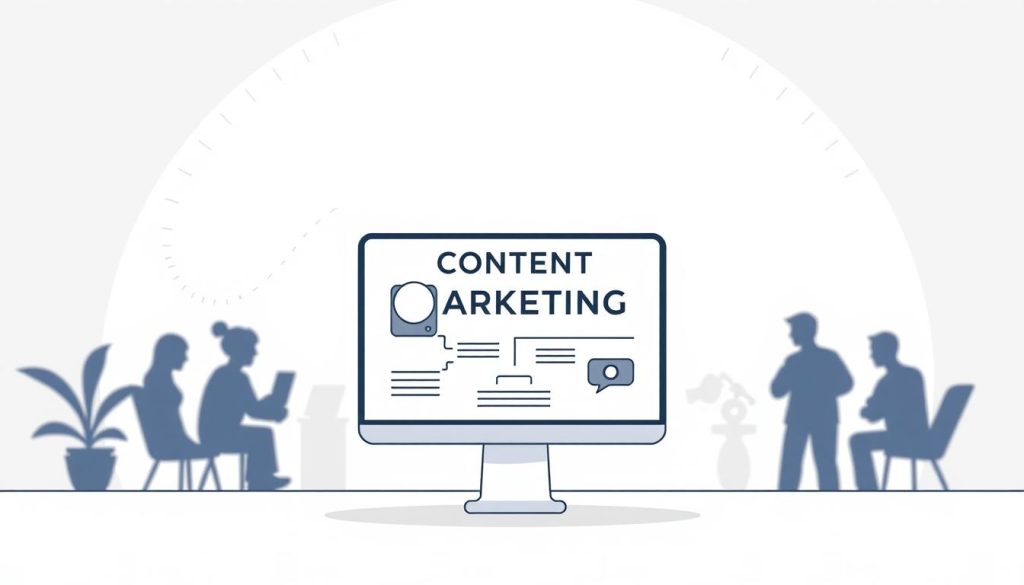We help businesses thrive by leveraging effective content marketing strategies. The industry is booming, projected to be worth $600 billion by 2024, because it delivers measurable business growth when executed correctly.
Our comprehensive guide breaks down the exact guidelines that separate successful campaigns from those that waste resources. By distilling years of expertise into actionable advice, we provide a roadmap for creating a content marketing strategy that drives sustainable business growth.
We’ll show you how to build a marketing strategy that creates compounding returns over time. Whether you’re just starting out or looking to optimize your existing approach, our guidelines work across industries.
Key Takeaways
- Understand the principles behind successful content marketing.
- Learn how to create a strategy that drives business growth.
- Discover advanced tactics for sustainable returns.
- Optimize your existing content marketing approach.
- Build a roadmap for long-term success.
Understanding Content Marketing Fundamentals
To achieve sustainable business growth, understanding the fundamentals of content marketing is essential. Content marketing is not just about producing content; it’s about creating a strategic approach to attract and retain a clearly defined audience.
What Is Content Marketing?
Content marketing is a strategic marketing approach focused on creating and distributing valuable, relevant, and consistent content to attract and retain a clearly defined audience. It’s about providing value to your customers through various types of content, such as blog posts, videos, and social media posts, to ultimately drive profitable customer action.
When brands produce great content, their audience keeps coming back for more. This helps capture the attention of your target audience for longer and reinforces positive experiences with your brand. As a result, your audience is more likely to think of and trust your brand when they’re looking to make a purchase.

Why Content Marketing Matters for Business Growth
Content marketing matters for business growth because it aligns perfectly with how modern customers make purchasing decisions—through research, education, and trust-building. By establishing your brand as a trusted resource through valuable content, you’re positioning yourself as the obvious choice when customers are ready to buy.
The benefits of content marketing are backed by data. For instance, content marketing costs 62% less than traditional marketing while generating three times as many leads per dollar spent. Businesses with robust content marketing strategies outperform competitors in customer acquisition, retention, and lifetime value metrics.
| Content Marketing Benefits | Traditional Marketing | Content Marketing |
|---|---|---|
| Cost | Higher | 62% less |
| Lead Generation | Less effective | Three times as many leads per dollar spent |
| Customer Acquisition and Retention | Limited impact | Outperforms in customer acquisition, retention, and lifetime value |
- Business growth directly correlates with your ability to build and maintain customer relationships at scale—content marketing is the most efficient way to achieve this.
- Content marketing creates a compounding effect where each piece of content continues working for your business long after publication.
- The businesses that struggle with growth are often the same ones treating content as an afterthought rather than a core business strategy.
The Business Impact of Effective Content Marketing
The power of content marketing lies in its ability to drive business growth through trust and authority. By creating valuable and relevant content, businesses can establish a strong connection with their audience and foster loyalty.
Effective content marketing has a significant impact on a business’s bottom line. Here are some key benefits:
- Trust has become the scarcest resource in business today—content marketing is the most efficient way to build it systematically at scale.
- When you consistently deliver valuable content that solves real problems, you establish authority in your industry that competitors can’t easily replicate.
- Businesses with strong content marketing programs require 40% fewer touchpoints to convert prospects into customers because trust is pre-established.
ROI and Compounding Returns
Investing in content marketing yields significant returns over time. As your audience grows and becomes more engaged, the value of your content compounds, leading to increased brand visibility and credibility. For more insights on content marketing strategies, explore our resources.

Building Trust and Authority at Scale
Content marketing allows you to demonstrate expertise rather than just claim it—showing rather than telling builds credibility that advertising simply cannot match. The authority you build through content marketing extends beyond your direct audience as your content gets shared, cited, and referenced by others in your industry. This, in turn, strengthens your brand identity and fosters a loyal customer base.
By leveraging content marketing effectively, businesses can build trust with their potential customers at scale, driving long-term growth and success.
Developing Your Content Marketing Strategy
The foundation of a successful content marketing strategy lies in understanding your target audience, setting clear goals, and conducting thorough competitor research. This strategic approach enables businesses to create content that resonates with their audience and drives meaningful engagement.
Identifying Your Target Audience
Understanding your target audience is crucial for creating effective content marketing. You need to identify their needs, preferences, and pain points to develop content that addresses their concerns. By analyzing your audience’s demographics, behaviors, and interests, you can create buyer personas that guide your marketing efforts.
Setting Clear Content Marketing Goals
Setting clear marketing goals is essential for measuring the success of your content marketing strategy. You need to define what you want to achieve through your content, whether it’s increasing brand awareness, generating leads, or driving sales. By establishing specific, measurable, achievable, relevant, and time-bound (SMART) goals, you can focus your efforts and allocate resources effectively.

Conducting Competitor Analysis
Analyzing your competitors is a critical component of developing a successful content marketing strategy. By examining their content, you can identify gaps and opportunities that others have missed. A systematic approach to competitor analysis involves examining their topics, formats, distribution channels, and engagement patterns. This helps you understand what’s working in your industry and how you can differentiate your content marketing efforts.
Some key aspects to consider during competitor analysis include:
- Identifying the types of content that resonate with your shared audience.
- Analyzing the distribution channels used by your competitors and their effectiveness.
- Examining the engagement patterns to understand what drives audience interaction.
- Finding content gaps that your competitors have not addressed.
By understanding your audience, setting clear goals, and analyzing your competitors, you can develop a marketing strategy that drives results and sets your business up for success.
Essential Content Marketing Guidelines for Success
The path to content marketing success is paved with strategic guidelines that prioritize audience needs and deliver tangible value. As the digital landscape becomes increasingly crowded, businesses must focus on creating content that not only resonates with their audience but also stands out from the competition.

Consistency and Quality Balance
Striking the right balance between consistency and quality is crucial for a successful content marketing strategy. Consistency helps build anticipation and trust with your audience, while quality ensures that your content remains relevant and valuable. We recommend maintaining a consistent schedule while ensuring that each piece of content meets your quality standards.
To achieve this balance, businesses should focus on creating a content calendar that outlines their publishing schedule and content themes. This approach enables teams to plan ahead, allocate resources effectively, and maintain a consistent flow of high-quality content.
Value-First Approach
Adopting a value-first approach is at the heart of effective content marketing. This means prioritizing the needs of your audience and providing them with genuine value before asking for anything in return. By doing so, businesses can build trust, foster engagement, and ultimately drive conversions.
- Focus on solving real problems for your audience, rather than thinly disguising product pitches as “helpful information.”
- Recognize that value means different things to different audiences; it could be entertainment, education, inspiration, or practical tools.
- Understand that the trust built through consistently valuable content creates a permission-based relationship where promotional content is welcomed rather than resisted.
By embracing a value-first approach, businesses can differentiate themselves in a crowded market and establish a loyal audience that is more likely to engage with their content and ultimately convert into customers.
Content Types That Drive Business Growth
To drive business growth, companies must leverage a mix of content types that resonate with their target audience. A well-rounded content marketing strategy is essential for engaging potential customers and establishing a brand’s authority in the market.
The following are key content types that businesses can utilize to drive growth:
Blog Posts and Long-Form Content
Blog posts and long-form content are foundational elements of a content marketing strategy. They provide in-depth information on topics relevant to a business’s target audience, helping to establish the brand as a thought leader in its industry. Long-form content, such as e-books and whitepapers, can be particularly effective for generating leads.
Video Content and Webinars
Video content has become increasingly popular, with many businesses using it to convey complex information in an engaging and easily digestible format. Webinars, a form of live video content, allow for real-time interaction with the audience and can be highly effective for building trust and generating leads.

Podcasts and Audio Content
Podcasts and other forms of audio content offer a unique way to connect with audiences, particularly those who prefer consuming information on-the-go. By creating high-quality, engaging audio content, businesses can build a loyal following and drive engagement.
Social Media Content
Social media content is excellent for generating brand awareness, and many brands, particularly those in the B2C space, rely heavily on social media for audience building. Social media marketing is also becoming increasingly popular among B2B brands as more and more people turn to individual thought leaders for professional advice and industry news. Effective social media content focuses on starting conversations rather than broadcasting messages.
| Content Type | Primary Benefit | Target Audience |
|---|---|---|
| Blog Posts and Long-Form Content | Establishes thought leadership | Potential customers seeking in-depth information |
| Video Content and Webinars | Engages audience and builds trust | Visual learners and those seeking interactive experiences |
| Podcasts and Audio Content | Builds loyalty and drives engagement | Audience members who consume content on-the-go |
| Social Media Content | Generates brand awareness and starts conversations | B2C and B2B audiences seeking industry insights and advice |
By incorporating these content types into a comprehensive content marketing strategy, businesses can drive growth, engage their target audience, and establish themselves as industry leaders.
Creating a Content Marketing Funnel
To drive business growth, it’s essential to develop a content marketing funnel that resonates with your target audience. A content marketing funnel is designed to guide potential customers through their buying journey, from initial awareness to making a purchase.
Awareness Content
At the top of the funnel, the focus is on creating awareness about your brand or product. This involves producing high-quality, engaging content that addresses the needs or interests of your target audience. Examples include blog posts, social media content, and educational videos.
Consideration Content
As prospects move down the funnel, they enter the consideration phase. Here, they are evaluating different solutions to their problems. Consideration content should provide more detailed information about your product or service, highlighting its benefits and unique selling points. Webinars, case studies, and comparison guides are effective formats at this stage.
Decision Content
At the bottom of the funnel, prospects are ready to make a decision. Decision-stage content is crucial as it provides the final push needed to convert prospects into customers. This can include free trials, detailed customer testimonials, success stories, and product demonstrations. The goal is to remove any remaining objections and make the purchase process as smooth as possible.
- Bottom-of-funnel content directly supports purchase decisions by removing final obstacles and reinforcing the value proposition.
- Effective BOFU content addresses remaining objections head-on while emphasizing the unique benefits that differentiate your solution from alternatives.
- Content formats like product demonstrations, customer testimonials, and implementation guides typically drive the highest conversion rates at the decision stage.
By structuring your content in this way, you can create a seamless and persuasive marketing strategy that drives business growth.
Content Distribution Strategies
Effective content distribution is crucial for maximizing the reach and impact of your content marketing efforts. A well-planned distribution strategy ensures that your content reaches your target audience at the right time.
Platform Selection
Choosing the right platforms for content distribution is critical. Different platforms cater to different audience segments and have unique characteristics that affect content performance. For instance, LinkedIn is ideal for B2B content, while Instagram and Facebook are more suited for B2C audiences.
| Platform | Audience Type | Content Type |
|---|---|---|
| B2B | Professional, industry insights | |
| B2C | Visual, lifestyle | |
| B2C | Diverse, community-driven |
Timing and Frequency
Timing and frequency are crucial elements of a successful content distribution strategy. Understanding your audience’s behavior patterns and the algorithms of the platforms you’re using can significantly enhance your content’s visibility and engagement.
- Analyze engagement metrics to determine the best times to post.
- Maintain a consistent posting schedule to build audience expectations.
- Adjust your frequency based on platform-specific best practices.
By strategically planning your content distribution, you can maximize your reach, engagement, and ultimately, the ROI of your content marketing efforts.

Content Repurposing Techniques
Maximizing content ROI requires innovative repurposing techniques that breathe new life into existing assets. We achieve this by transforming a single piece of content into multiple marketing assets, thereby extending its reach and lifespan.
Transforming One Piece into Multiple Assets
Effective content repurposing involves creating various formats from a single piece. For instance, a comprehensive whitepaper can be repurposed into:
- Blog posts summarizing key points
- Infographics highlighting statistics
- Webinar content expanding on the topic
- Social media snippets for audience engagement
This approach not only saves time and resources but also ensures that the content reaches different audience segments across various media channels.
Cross-Platform Content Adaptation
Adapting content for different platforms is crucial for maximizing its impact. We consider the unique context, audience expectations, and technical constraints of each distribution channel. For example, a video created for YouTube can be adapted for Instagram Reels or TikTok by adjusting its length and format. Successful cross-platform content maintains its core messaging while adapting to each platform’s native environment. This strategy enables us to leverage the strengths of various social media platforms and engage our audience more effectively.
By repurposing content across multiple platforms and channels, we can significantly enhance our content marketing efforts, ensuring that our message reaches and resonates with our target audience wherever they are.
Measuring Content Marketing Success
Measuring the success of your content marketing strategy is pivotal for making informed decisions that drive business growth. To effectively gauge this success, you need to focus on key areas that provide actionable insights.
Key Performance Indicators (KPIs)
To measure content marketing success, you must identify and track relevant KPIs. These indicators help you understand how your content is performing and where improvements are needed. Common KPIs include website traffic, engagement metrics (such as likes, shares, and comments), conversion rates, and lead generation.
By monitoring these KPIs, you can assess the effectiveness of your content marketing efforts and make data-driven decisions to optimize your strategy. For instance, if your blog posts are driving significant traffic but not converting visitors into leads, you may need to adjust your call-to-action (CTA) or the content’s relevance to your target audience.
Analytics Tools and Dashboards
Most marketers rely on Google Analytics to track their content marketing efforts, while others utilize third-party tools like SEMrush or Ahrefs to measure these metrics. Centralizing your data in one platform not only streamlines your analysis but also opens the door for AI-driven insights. For example, tools like Asana leverage AI to help teams create faster status updates, summarize key highlights, and identify potential blockers.
Effective analytics infrastructure should consolidate data from multiple platforms into unified dashboards, providing actionable insights rather than just raw numbers. Businesses with integrated analytics systems make better content decisions faster than those manually compiling reports from disparate sources.
- Analytics infrastructure should consolidate data from multiple platforms into unified dashboards that provide actionable insights, not just raw numbers.
- We’ve found that businesses with integrated analytics systems make better content decisions faster than those manually compiling reports from disparate sources.
- Effective analytics setups automate routine reporting while allowing for deeper custom analysis when needed—balancing efficiency with insight depth.
- The businesses that excel at content analytics establish clear ownership and review processes to ensure data actually drives decisions rather than collecting dust.
- Strategic tool selection should prioritize systems that integrate with your existing marketing stack—data silos significantly reduce the value of your analytics.
- Your analytics dashboard should be accessible to all content stakeholders, not just analysts—democratizing data access improves content decision-making across teams.
- Understanding both the capabilities and limitations of your analytics tools prevents misinterpretation and ensures you’re measuring what actually matters.
Building a Content Calendar and Workflow
Now that you have a solid content strategy, it’s time to bring your team together and tackle your content calendar. A well-structured content calendar is crucial for organizing and scheduling content across different channels and teams. It ensures that everyone is on the same page and working towards common goals.
Editorial Calendar Development
Developing an editorial calendar involves planning and scheduling content in advance. This process helps in maintaining consistency and quality across all content pieces. When creating your editorial calendar, consider the types of content that will resonate with your audience and align with your marketing goals.
Key considerations include: identifying content themes, deciding on content formats (blog posts, videos, social media posts), and planning for seasonal or timely content.
Content Production Process
The content production process is where the actual creation of content happens. To ensure efficiency and quality, it’s essential to have a streamlined process in place. This involves defining roles and responsibilities within the team, setting up a review and approval process, and utilizing project management tools to track progress.
- Streamlined content production processes eliminate bottlenecks and ensure consistent quality.
- Clearly defined workflows reduce delays and miscommunication among team members.
- Effective content production includes built-in quality control checkpoints.
- Establishing clear roles and responsibilities is crucial for successful content production.
- Strategic process design balances efficiency with creative flexibility.
- Contingency plans for common obstacles should be part of your production workflow.
- Understanding your team’s capacity helps in setting realistic timelines.
Advanced Content Marketing Tactics
Advanced content marketing tactics can significantly enhance your marketing strategy’s effectiveness. As you refine your content marketing approach, incorporating sophisticated techniques can lead to substantial results.
Audience Research and Community Building
Understanding your audience is crucial for creating impactful content. We recommend conducting thorough audience research to identify their needs, preferences, and pain points. This involves analyzing data, engaging with your community, and creating buyer personas to guide your content creation.
Building a community around your brand fosters loyalty and encourages engagement. Strategies include creating interactive content, hosting webinars, and leveraging social media platforms to facilitate discussions.
- Conduct surveys and polls to understand audience preferences
- Create forums or discussion groups for community engagement
- Host webinars or live events to educate and interact with your audience
Tasteful Product Integration
While content marketing should educate potential customers, it also needs to sell them at some point. The key to tastefully pitching your product or service is ensuring it’s genuinely a good solution to the problem the potential customer is researching.
Effective product integration follows the 80/20 rule—at least 80% pure value, with product mentions comprising no more than 20% of your content. Businesses that excel at product integration focus on solving problems first, then introducing their product as one possible solution among others.
- Maintain trust by providing value-first content
- Introduce your product as a natural solution to the problem discussed
- Acknowledge alternatives and highlight your unique advantages
By incorporating these advanced content marketing tactics, you can enhance your marketing strategy, build a loyal community, and drive business growth through tasteful product integration.
Common Content Marketing Challenges and Solutions
The landscape of content marketing is fraught with challenges, but with the right strategies, businesses can overcome them. As the digital landscape becomes increasingly crowded, companies must navigate various obstacles to effectively reach and engage their target audience.
Consistency and Resource Constraints
One of the primary challenges businesses face is maintaining consistency in their content marketing efforts while dealing with resource constraints. Effective content marketing requires a sustained effort, but many companies struggle to allocate the necessary resources. To address this, businesses can:
- Develop a content calendar to plan and organize content in advance
- Repurpose existing content to maximize its value
- Invest in content creation tools to streamline the production process
Content Saturation and Standing Out
Another significant challenge is content saturation, where the sheer volume of content makes it difficult for a brand to stand out. To combat this, businesses should focus on creating unique, high-quality content that offers a fresh perspective or insight. Key strategies include:
- Conducting thorough research to understand the existing content landscape
- Developing a distinct brand voice and perspective
- Utilizing innovative formats and distribution channels
By understanding these challenges and implementing effective solutions, businesses can enhance their content marketing efforts and achieve their goals. It’s essential to stay adaptable and continually assess and refine your content marketing strategy to overcome the evolving challenges in the digital landscape.
Conclusion
By now, it’s evident that content marketing is not just a tactic, but a fundamental business strategy that drives sustainable growth. As we’ve explored throughout this guide, creating genuine value for your audience is paramount. This approach not only builds trust but also establishes your brand as an industry leader.
The most successful content marketers understand that consistency and quality are key to achieving long-term success. It’s a marathon, not a sprint, where compounding returns come to those who maintain their efforts over time. We’ve seen firsthand how businesses that commit to these content marketing guidelines outperform their competitors.
A strategic content marketing strategy requires both creative excellence and analytical rigor. The art and science of content marketing must work together for optimal results. Your success ultimately depends on creating genuine value for your audience before expecting value in return. This reciprocity principle is the foundation of all effective content.
Understanding that content marketing is an investment in business growth, not just a marketing expense, changes how you approach resource allocation and performance measurement. The landscape continues to evolve, but the fundamental guidelines remain constant because they’re built on human psychology and business principles.
Implementing these expert content marketing guidelines will position your business for sustainable growth by building valuable audience relationships that translate into revenue and competitive advantage. Remember, the most powerful content marketing doesn’t feel like marketing at all—it feels like a valuable resource that happens to come from a brand your audience grows to trust and support.
